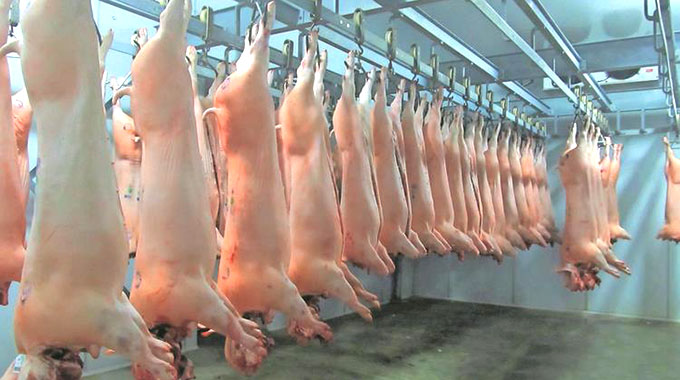
Resuscitated in 2010, the mission of PPAZ is to represent the pig industry with one unified voice and to promote and educate for a sustainable and socially responsible, profitable and globally competitive pork industry. The launch of the European Union-funded Zimbabwe Agricultural Growth Programme Pig Value Chain Initiative led by ActionAid Zimbabwe (AAZ) will also take place at the event.
AAZ is collaborating with two private sector integrators in the pig industry, Braford Enterprises and Shamiso Farms, to implement the project and the initiative is focused on transforming and promoting the pork value chain in Zimbabwe to supply safe, quality assured pork and pork products.
The project will also work with the Pig Industry Board (PIB) to formalise the establishment of two Pork Production Business Syndicates in Mashonaland East and West provinces for efficient delivery of value-added business services to members through collective business strategies.
Domestic pig industry
The fortunes of the industry have been on an upward trend following interventions by Government and the private sector and is currently made up of nearly 19 000 sows (adult female pig) with an estimated herd in excess of 400 000 pigs.
Pig slaughters through formal abattoirs have grown by more than 40 percent from 120 000 in 2013 to more than 170 000 in 2018. The increase in pig farming activities over the years following a dip in early 2000 has been driven by technical training at a nominal cost, effective stockfeed manufacture, improved genetics and better market access for pork products.
An increasingly health conscious consumer has increased the consumption of white meat as part of a balanced diet which has benefited the pork industry.
Global dynamics
Global meat consumption excluding fish and seafood sources for 2013 according to the Food and Agricultural Organisation was 43kg per capita with pork accounting for 37 percent.
In Africa, meat consumption averaged 19kg per capita with pork consumption accounting for only 8%. According to the Zimstat’s Poverty Income and Expenditure Survey (PICES) of 2011, Zimbabwean meat consumption in the same year was 9kg per capita of which the consumption of pork made up 5 percent.
The local pig industry has scope to increase market share in the long term by promoting the consumption of pork. The current trade tensions between major economies of the US and China and the outbreak of African Swine Fever (ASF) in China present short term opportunities to enter the export market if quality standards and competitive production practices are adhered to.
Domestic mrket
Economic difficulties exacerbated by severe weather shocks have characterised the operating environment in Zimbabwe. The effects of drought on agricultural production and electricity generation, the impact of cyclone Idai and the significant fiscal consolidation have dampened the business environment.
The February currency reforms and the depreciation of the exchange rate has fostered high inflation which reached almost 300 percent (year-over-year) in August.
The pig industry has not been spared from the adverse effects of the deteriorating economic environment as the costs of stockfeed and the bottlenecks in the supply of soya meal and maize has put price pressures on pork products.
Pig producers and processors alike have reduced margins as they absorb some cost pressures. Disposable incomes have been noticeably eroded by inflation, resulting in intense price competition amongst the different animal proteins.
Health
Globally, the continuing outbreaks of ASF has raised concern among animal health experts and the industry at large.
The ASF virus is of the Asfarviridae family which causes haemorrhagic fever with high mortality rates in domestic pigs.
The Chinese pig industry has been devastated by ASF with their pig herd estimated to have declined by 39 percent to 200 million head to August 2019. As a result, pork prices have spiked by 40 percent this year.
Outbreaks have also been reported in North and South Korea, Vietnam and most recently, Australia.
Closer to home, 14 outbreaks of ASF have been reported in South Africa in the North West, Mpumalanga, Gauteng and the Free State provinces, mainly among smallholder farmers.
Locally, an outbreak of ASF has been contained in the north-east of the country bordering Mozambique and producers have been encouraged to implement high biosecurity standards.
Symposium 2019
In order to maximise the profitability of a pig enterprise, “Back to Basics” is the theme of the symposium and this one day event will remind pig producers of their underlying core business functions and position their operations for enduring commercialisation and profitability.
Technical sessions are a key part of the Symposium and this year’s programme includes farmer testimonials from their humble beginnings to success and presentations on livestock financing and alternatives and export opportunities.
The afternoon session is devoted to managing pig farms and includes topics such as alternative feed sources, practical feeding concepts and pig health.
The Pig Symposium “Back to Basics” is open to everyone interested in pigs. Exhibitors will also showcase their poultry stockfeed and animal health products.
The one-day event starts with registration at 08.30am and costs ZWL 150 per person including teas, a hot lunch and an information pack. Join pig farmers, experts and other stakeholders in an informative day of discussion and networking on pig production.
